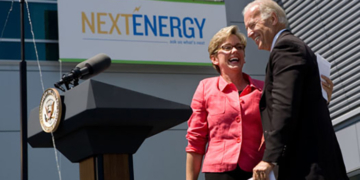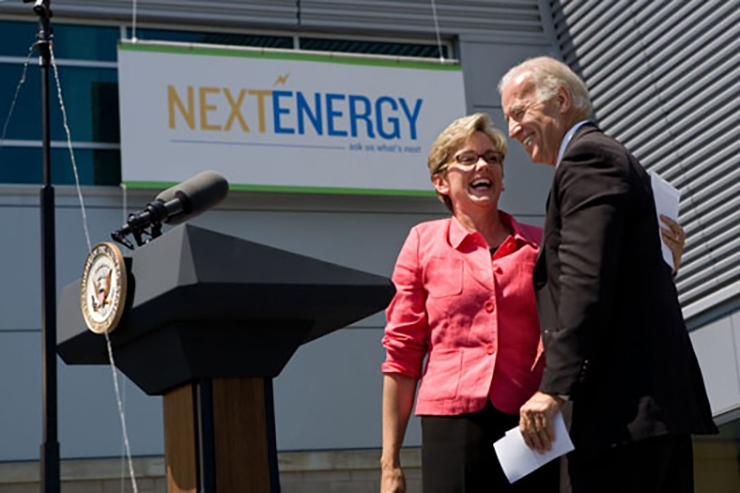The Senate sent one of the most significant pro-nuclear energy bills in recent history to President Joe Biden’s desk this week, but the bill alone is unlikely to spur a nuclear renaissance in the U.S.
The ADVANCE Act passed the Senate on Tuesday by a strong 88-2 bipartisan vote to the applause of pro-nuclear organizations who described the bill as a major step forward for America’s energy future. The bill is a first step toward freeing up a nuclear industry that has long been shackled, but it does not address some impediments the industry faces, according to nuclear energy experts.
The bill is designed to bring down the costs of nuclear licensing, create new opportunities for old industrial sites to eventually be converted to host reactors and give the Nuclear Regulatory Commission (NRC) more staffers and resources to execute their mission, according to the office of Republican West Virginia Sen. Shelley Moore Capito, a key architect of the bill. The bill is a welcomed development for the nuclear industry, which has struggled to expand for decades despite growing momentum — especially on the environmental left — to decarbonize the U.S. power system and wider economy.
Dems Who Shrieked About Climate Apocalypse Voted Against Bill Promoting Emissions-Free Nuclear Powerhttps://t.co/KWk0oN08HW
— Daily Caller (@DailyCaller) February 29, 2024
“This bipartisan legislative package ensures the U.S. maintains its leadership on the global stage and helps meet our climate and national energy security goals,” Maria Korsnick, president and chief executive officer at the Nuclear Energy Institute (NEI), said of the bill. “The passage of the ADVANCE Act allows us to bolster U.S. international competitiveness at this crucial junction, accelerate the domestic deployments of innovative advanced nuclear technologies, and modernize the oversight and licensing of the operating fleet of reactors.”
However, the bill is not a total victory for those hoping to see a speedy expansion of the technology’s footprint, as issues like the NRC’s general attitude of risk aversion and a lack of robust financial protection against cost overruns are not addressed directly by the legislation.
“The Nuclear Regulatory Commission has made recent progress to become more efficient while maintaining its focus on safety, but there is more work to be done,” Korsnick added. “The bill will support efforts to further modernize the NRC as it prepares to review an ever-increasing number of applications for subsequent license renewals, power uprates and next generation nuclear deployments.”
John Starkey, the director of public policy for the American Nuclear Society, told the DCNF that the bill is a “step in the right direction,” but probably will not be enough to singlehandedly usher in a nuclear renaissance.
“ANS applauds the long awaited passage of the ADVANCE Act. This bill provides common sense direction to enable the accelerated deployment of advanced nuclear reactors needed to meet the world’s clean energy goals,” Starkey told the DCNF. “The bill alone won’t open any floodgates, but it’s a necessary step in the right direction due to added workforce and the streamlined approach the NRC can take when regulating advanced reactors.”
While the NRC is set to get a boost from the new bill should it be signed into law, the institution is thought by some energy experts — including Dan Kish, a senior fellow at the Institute for Energy Research — to be too conservative and risk-averse in its approach to regulating the industry. Kish believes that the NRC has created a “regulatory morass” out of risk aversion over time that holds nuclear power back by significantly driving up costs, as he previously told the Daily Caller News Foundation.
As of August 2023, there were 54 operational nuclear power plants and 93 commercial reactors in America, which together provide approximately 19% of America’s power, according to the U.S. Energy Information Administration (EIA). The average nuclear reactor is about 42 years old, while licensing rules limit their lifespans to an upper limit ranging from 40 to 80 years, according to EIA.
Nuclear power capacity grew rapidly between roughly 1967 and 1997, but it has generally stayed flat since then, according to the EIA. Only a handful of new nuclear reactors have come online in the past twenty years, but nuclear generally remains a more reliable low-carbon source of power than solar and wind, an important consideration when taking stock of the Biden administration’s goals to decarbonize the U.S. power sector by 2035 and the overall economy by 2050.
Grid watchers have warned consistently that the nation’s grid may not be able to sustain considerable growth in electricity demand amid simultaneous retirement of reliable fossil fuel-fired generation and its replacement with intermittent solar and wind, for example. Hence, nuclear power may hold the keys to recognizing the decarbonized future Biden and his appointees are pursuing with aggressive regulation and spending.
EXCLUSIVE
from @mikeginsberg98
Members Of Congress Push Defense Department To Embrace Nuclear Energy https://t.co/KeYmwzHj6X
— Daily Caller (@DailyCaller) July 13, 2023
To that end, the Biden administration evidently recognizes the promise of nuclear power, and is making a big push to advance it.
The Biden administration signed onto a pledge at last year’s United Nations climate summit to triple nuclear energy capacity by 2050, and has also extended “billions and billions and billions” of dollars to spur a nuclear revival in the U.S., as Energy Secretary Jennifer Granholm said at a nuclear energy conference in June. On Monday, Granholm’s Department of Energy (DOE) announced $900 million in funding to advance deployment of next-generation small modular reactors.
Two of the most recent nuclear reactors to come online are Unit 3 and Unit 4 at the Alvin W. Vogtle Electric Generating Plant, a nuclear power plant located in Georgia. Those reactors finally came online after years of delays and billions of dollars of cost overruns, demonstrating the challenges that the complex nature of nuclear engineering and construction can pose.
Tim Echols, a commissioner on the Georgia Public Service Commission, also praised the bill, but he raised different issues than other energy sector experts who focused more on the role of the NRC. Echols was involved in getting the Vogtle projects over the finish line in his capacity as a commissioner for the entity regulating the state’s utilities.
“What I am most encouraged about with ADVANCE is the bipartisan support for nuclear. For too long, only Republican-run states have been interested in new nuclear — and those times seem to be coming to an end,” Echols told the DCNF. “While ADVANCE doesn’t have the federal financial backstop I have been asking for, which would protect against overruns caused by bankruptcies, it still is very positive. “Speeding up licensing will allow the technology to be deployed sooner — assuming you have states stepping forward with the courage to build new nuclear.”
The backstop that Echols describes would be some sort of federal bankruptcy protection, which would incentivize policymakers and developers to move forward with new projects because “building new nuclear power is still incredibly risky,” and utility commissioners across America may hesitate to do so without some protection against what we went through in Georgia.”
“Clearly, ADVANCE, and the recent White House efforts on behalf of nuclear energy represent a push to accelerate new nuclear deployment in the United States that we haven’t seen since I was a boy,” Echols told the DCNF.
The DOE did not respond immediately to a request for comment, and the NRC declined to comment because the legislation has yet to be signed into law.
Featured image credit. Official White House Photo by David Lienemann.
All content created by the Daily Caller News Foundation, an independent and nonpartisan newswire service, is available without charge to any legitimate news publisher that can provide a large audience. All republished articles must include our logo, our reporter’s byline and their DCNF affiliation. For any questions about our guidelines or partnering with us, please contact [email protected].

















 EXCLUSIVE
EXCLUSIVE Continue with Google
Continue with Google